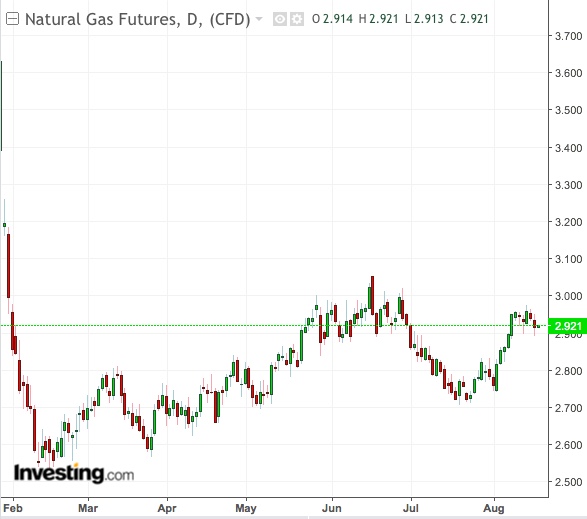US energy bulls who missed their chance to profit from $3 natural gas this summer—despite overwhelming demand for air-conditioning—are setting their sights on the upcoming winter, when inventories of the fuel could be at unusually low levels.
The break in the market’s rally also presents an opportunity for another group: utilities companies that have to stock up for heating needs, and can do so at cheaper prices before the weather gets colder.
“We’ve told our clients, who are mostly utilities, power generation companies and others involved in the physical gas market to take a break from buying as we expect prices to soften in the next couple of months,” said Daniel Myers, analyst at Gelber & Associates, a Houston-based consultancy for natural gas.
“These customers don’t trade the market and they don’t want to get caught into any whiplash volatility. Once prices relax a bit off the highs, I think there’ll be a good window, probably in September or October, for them to buy.”
Natural gas has become the power source of choice for American utilities that are increasingly abandoning coal due to carbon emission worries. But generous, free flow of gas from fracking fields around the country also means spikes in air-conditioning and heating demand are more easily met these days, compared to a few years ago.
Less Upward Price Pressure On Market
As a result, there are fewer upward pressures on the market—and less chances for a hedge fund to make a killing with high prices.
“One example was this summer, when $3 remained elusive,” Myers said, referring to the target price per million British thermal units (mmBtu) that most traders had for natural gas the past two months.

Myers shares the belief of many that natural gas will hit $3 per mmBtu and beyond this winter. But with near-term weather forecasts looking mixed across the United States, he expects some difficulty in defending recent highs. “I expect prices to moderate in the next couple of weeks, back to the $2.80 or probably $2.75 levels.”
Mike Seery of Seery Futures in Plainfield, Illinois, concurs. “I do think prices might retrace from these levels as volatility certainly has increased over the last several weeks, going into the autumn and winter seasons,” Seery wrote in a commentary on Thursday.
In Thursday’s session, natural gas’ front-month contract on the New York Mercantile Exchange, September, settled at $2.908. The market did breach $3 several times in June, getting to a 5-month high of $3.053, but was unable to hold those peaks.
Currently, only the “winter strip” of December 2018 through March 2019 have settlements above $3. Those contracts are fetching a premium because of the thinner-than-usual injections of gas into storage this summer after whatever was burnt to generate power demand for air-conditioning. The injections, meant as backup for winter heating, have fallen below trade expectations in five weeks out of the past six, pushing inventories at this time of the year to below the five-year average.
Technicals Still Call For A “Buy”
Despite its sluggish price action, September gas was still deemed a “Strong Buy” on Investing.com’s daily technicals. In Friday’s pre-market call, Fibonacci patterns put Level 3 resistance for September gas at $2.976 per mmBtu – meaning the contract could rise nearly seven cents more from Thursday’s settlement.
Dominick Chirichella of the Energy Management Institute in New York says there’s a push-and-pull in natural gas now with traders focused on both the lingering cool down of temperatures in middle America versus the extraordinarily low gas in reserve for the winter.
In terms of weather, “the forecast is projecting a widening of the cooling trend over middle section of the US”, which would be bearish, Chirichella wrote in his Thursday note.
But that was being offset by the bigger——and bullish—picture of thin gas stockpiles held in underground salt caverns and other storage now, “with all models projecting the deficit to continue right to the start of the upcoming winter heating season”, he added.
